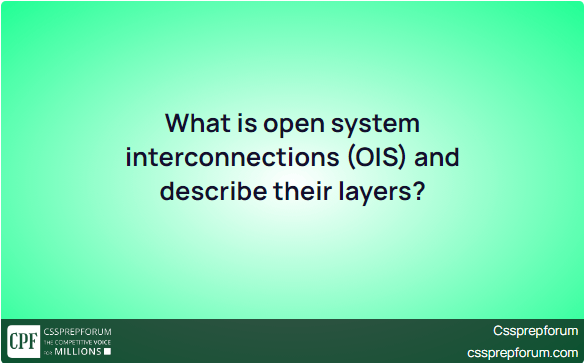The General Science and Ability Past Paper Question has been attempted by Hamza Kaim Khani, a CSS English and Compulsory Course student. Along with other aspirants, she learns how to prepare and attempt GSA questions to score up to 90 marks under the guidance of Miss Iqra Ali and Dr. Nishat Baloch, Pakistan’s top CSS GSA coaches providing coaching at Howfiv.
CSS Solved GSA 2020 Paper | What is open system interconnections (OIS) and describe their layers?
Open System interconnections (OSI)
OSI is a data communication standard that contains rules and instructions. It is used to guide two computers or networks on how they are supposed to communicate effectively with each other. In other words, it is a reference model that is used to describe how information from one software application, Whatsapp, Gmail, etc., of a computer, moves through physical medium to a software application in another computer. Furthermore, International Organisation for Standardization (ISO) possesses the credit of devising this model in 1984. Additionally, this model contains seven layers, in which each layer performs certain functions to facilitate communication.
Layers in an OSI model
OSI model is divided into seven layers: Physical, Data Link, Network, Transport, Session, Presentation, and Application. These layers exist at both sending and receiving ends. When data is sent from one computer to another, it is received by the presentation layer of sending computer. Then, this layer transfer data to its subsequent layer, the presentation layer. This process remains to continue until the data is received by its physical layer. Contrary to this, when a computer receives data, its physical layer gets the data first and then transfers the message to the layer above it. This process remains to continue until its application layer receives the information. Moreover, each layer in a computer interaction with its corresponding layer in the other computer. For example, the physical layer of the sender interacts with the physical layer of the receiver.
Functions of the layers:
- Physical layer:
It is the first layer of the OSI model. In this layer, the data received from the data link layer is called bits. It performs certain functions:
- Establishes medium to start communication:
It connects the devices through a medium that can be guided or unguided. Here, guided medium refers to a wired medium that can be fibre optic cable or Ethernet cable. However, an unguided medium denotes a wireless medium, the internet.
- Encodes data:
It also encodes the bits in analogue or digital signal in order to transfer them through the medium. For example, a stream of bits, 10101, is to be transferred through the medium. It is converted into 5 volts and 0-volt signals for 1 and 0 respectively.
- Defines transmission mode:
What is going to be the transmission mode is set by it. The mode can be simplex (one way), half-duplex (two way by at a time one remains active), or full-duplex (two-way data transmission simultaneously)
- Data link layer
It is called the second layer of the OSI model. In this layer, the terminology used to refer to data is the frame. The functions performed by it are given below:
- Formation of frames
This layer divides the data received from the network layer into frames by adding a header and a trailer. The header contains the destination address and the trailer has a calculated value to control error.
- Flow control
Sometimes the speed of sending and receiving devices to handle data varies, so the data link layer controls the flow of data being transferred to avoid any loss of data.
- Error control
This layer is also responsible for the transmission of error-free data. For this, a method named Cyclic Redundancy Check (CRC) is used. In this technique, a calculated value is added with a fragment through the trailer. When this data is received at the data link layer of the receiving computer, it verifies whether it is the same frame or not.
- Access control
In a network, multiple topologies, physical arrangements of devices, exist. Mostly, multiple computers, to reduce the cost of the network, are connected with a single cable. So, to access a single device is only possible when other devices are controlled. This is done by the data link layer.
- Network layer
It is the third layer of the OSI model. In this layer, the data received from the transport layer is called packets. It performs certain functions:
- Routing
Routing, the process of determining the best optimal path for the transmission of data, is a major function of this layer. For this, certain protocols, like Spanning Tree Protocol (STP), are used.
- Packetizing
It transforms the data received from the upper layer into packets. And it is achieved through Internet Protocol (IP)
- Transport layer
This layer is known as the fourth layer. The term segment is used to refer to the data got from the upper layer in it. The functions of this layer are mentioned below:
- End to end delivery
One, for example, can simultaneously access multiple websites by opening multiple tabs in a web browser. In this case, retrieving the relevant data from the server is a herculean task. This is done by the network layer.
- Flow control
Like the data link layer, it also performs the function of flow control, but it is more specifically concerned with flow control in a particular application in a device.
- Error control
It is also the same function of the data link layer, but the network layer is very much concerned about the delivery of data with any error in a particular tab of web browser or in an application
- Session layer
In a hierarchy of the seven layers, it comes at the fifth position. From now onwards, in each layer, the data is not referred to with any specific name. It receives data from the presentation layer and performs its functions
- Create session
In order to communicate with another device, these layers create a session with it. For instance, when somebody wants to call someone else, he dials its number. After this, a sound is heard by him, which is actually performed by this layer to create a session before the exchange of data.
- Adds checkpoints
It also adds checkpoints in order to optimize efficiency. For instance, if a computer sends a file of hundred pages, it adds a checkpoint after every ten pages. For some reason, if the receiver has received only seventy-three pages, this layer is to send only pages after the seventieth page.
- Presentation layer
It is the sixth layer of the OSI model.
- Convert data
It converts the data into a standard format. It can convert the data in that format understood by layers below it. It does this work through translation by using American Standard Code for Information Interchange (ASCII). In ASCII every character has an equivalent binary number.
- Encryption
This layer also encrypts the data in order to make it secure.
- Application layer
It is the last of the seven layers. This layer includes applications, web browsers etc. it interacts with the sender of the data. The most important functions of this layer are given below:
- Services to end user
This layer interacts with a user. This layer contains applications, through which the user receives or sends data.
- File transfer, access, and management
This layer helps the user t access the data present at a remote location. In addition to this, he or she can also manage his or her data.

References:
- https://www.javatpoint.com/osi-model
- https://www.forcepoint.com/cyber-edu/osi-model
- https://www.youtube.com/watch?v=cgRi4bRavDg&t=416s
Are you looking to learn English communication skills to qualify for the CSS and PMS English essay & Precis papers? Let’s join Sir Syed Kazim Ali and learn how to give your ideas and thoughts words, fluently and confidently.
CSS & PMS 2024 Extensive English Course

A quick recipe to score up to 90 marks in CSS GSA paper by Miss Iqra Ali and Dr. Nishat Baloch
Having taught for many years in different universities and being an experienced lecturer, I have devised a strategy for my CSS and PMS students, who aim to score up to 90 marks in the CSS GSA paper. Unfortunately, due to a large number of CSS and PMS aspirants, a very busy schedule, and Sir Syed Kazim Ali‘s rule of taking a limited number of students in CSS English and Compulsory Course to ensure quality rather than quantity and remain the best e-institute, I cannot teach all student. However, under the guidance of Sir Kazim, I have decided to highlight the best strategies that I teach my students to score maximum marks in the paper. All the students may follow them to pass the CSS GSA paper with flying colours. Moreover, to help thousands of CSS aspirants, I have created a separate category where I have uploaded the last 30 years of CSS GSA Solved Past Papers. Or, you can also visit the category GSA Notes, where my students publish their write-ups related to CSS GSA papers.
- Science is not a subject to cram. Therefore, aspirants must not cram the study material but try to grab the concepts and reproduce them on the paper in accordance to the requirements of the question.
- Rather than memorizing and reproducing the content from different sources, students must learn to give their thought words properly, coherently, affectively, and grammatically correct. This gives a pleasant and unique feeling to the examiner as he is always desperate to find the original and unique thoughts out of thousands of papers, and he always appreciates such aspirants by giving maximum marks.
- For preparing General Science, students must practice diagrams with as much topics as possible and reproduce them on the paper, for diagrams, illustrations, and graphs boost the score of the candidate.
- It is commonly observed that students take the MCQs portion very light. However, 20 marks of MCQs are very important as they not only boost the score but also morale of the student. Therefore, aspirants must give due attention and time to the preparation of MCQs portion. Fortunately, Howfiv is the only platform, where an aspirant can find millions of MCQs, along with their explanation, of all the subjects, including GSA, and MCQs should be prepared from Howfiv.
- Furthermore, Ability and Mathematics portion is critical and decisive for the future of a CSS and PMS aspirant. With a little effort and focus, an aspirant can grab full marks in this portion. Therefore, an aspirant must practice different mathematical skills throughout his preparation for the exam.
- Last but not the least, practicing the past papers and getting them evaluated by an expert teacher or lecturer, rather than mere a CSS or PMS qualifier, is the key to achieve up to 90 marks in CSS GSA paper.













